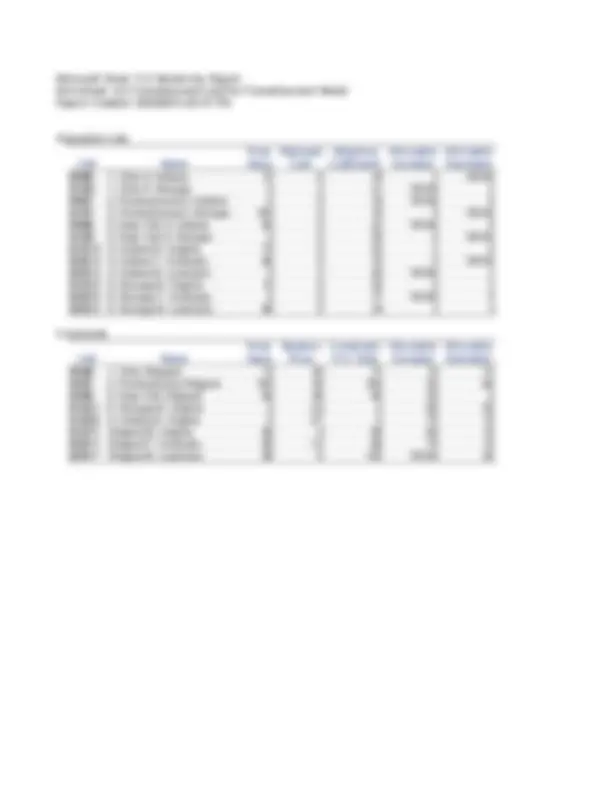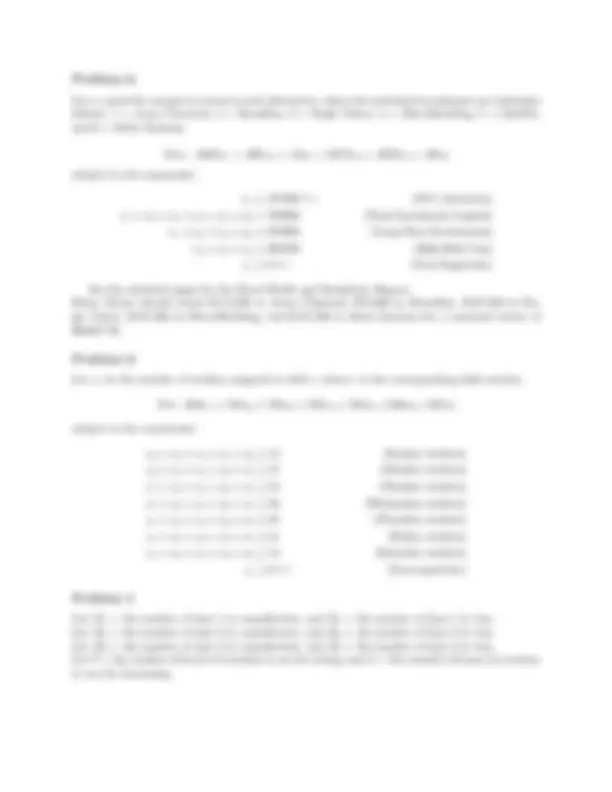





Study with the several resources on Docsity

Earn points by helping other students or get them with a premium plan


Prepare for your exams
Study with the several resources on Docsity

Earn points to download
Earn points by helping other students or get them with a premium plan
Community
Ask the community for help and clear up your study doubts
Discover the best universities in your country according to Docsity users
Free resources
Download our free guides on studying techniques, anxiety management strategies, and thesis advice from Docsity tutors
Material Type: Assignment; Class: Mathematics for Management Science; Subject: mathematics; University: Boston College; Term: Spring 2009;
Typology: Assignments
1 / 6

This page cannot be seen from the preview
Don't miss anything!




Let xij equal the number of tons of grapes shipped from node i to node j, where i and j are indexed as follows: 1 = Ohio, 2 = Pennsylvania, 3 = New York, 4 = Indiana, 5 = Georgia, 6 = Virginia, 7 = Kentucky, and 8 = Louisiana.
M in 16 x 14 + 21x 15 + 18x 24 + 16x 25 + 22x 34 + 25x 35
subject to the constraints:
Supply:
x 14 + x 15 = 72000 (Ohio) x 24 + x 25 = 105000 (Pennsylvania) x 34 + x 35 = 83000 (New York)
Pass-Through:
x 14 + x 24 + x 34 − x 46 − x 47 = 0 (Indiana) x 15 + x 25 + x 35 − x 56 − x 57 = 0 (Georgia)
Demand:
x 46 + x 56 ≤ 90000 (Virginia) x 47 + x 57 ≤ 80000 (Kentucky) x 48 + x 58 ≤ 120000 (Louisiana)
xij ≥ 0 ∀ i, j (Non-negativity)
See attached pages for the Excel model and Sensitivity Report. Walsh’s Fruit Company should ship 72 thousand tons of grapes from Ohio to Indiana, 105 thousand tons of grapes from Pennsylvania to Georgia, and 83 thousand tons of grapes from New York to Indiana. For the second shipment leg, they should ship 75 thousand tons of grapes from Indiana to Virginia, 80 thousand tons from Indiana to Kentucky, 15 thousand tons from Georgia to Virginia, and 90 thousand tons from Georgia to Louisiana. This shipping plan will have a minimal cost of $10,043,000.
(^2322212019181716151413121110987654321)
A B C D E F G H I J K
Walsh's Fruit Company Transshipment
Shipping Costs:
Tons
Farms
Supply
Shipped
Farms
72
(^0)
72
72
16
21
(^0)
105
105
105
18
16
83
(^0)
83
83
22
25
Shipped
155
105
Shipping costs:
Tons
Plants
Shipped
Plants
75
80
(^0)
155
23
15
29
15
(^0)
90
105
20
17
24
Demand
90
80
120
Shipped
90
80
90
Transshipment flows:
0 0
Cost =
10043
Distribution Centers
Distribution Centers
Plants
Plants
Let xi equal the amount to invest in each alternative, where the potential investments are indexedas follows: 1 = Acme Chemical, 2 = DynaStar, 3 = Eagle Vision, 4 = MicroModeling, 5 = OptiPro and 6 = Sabre Systems.
M ax. 0865 x 1 +. 095 x 2 +. 10 x 3 +. 0875 x 4 +. 0925 x 5 +. 09 x 6
subject to the constraints
xi ≤ 187500 ∀ i (25% restriction) x 1 + x 2 + x 3 + x 4 + x 5 + x 6 = 750000 (Total Investment Capital) x 1 + x 2 + x 4 + x 6 ≥ 375000 (Long-Term Investments) x 2 + x 3 + x 5 ≤ 262500 (High-Risk Cap) xi ≥ 0 ∀ i (Non-Negativity)
See the attached pages for the Excel Model and Sensitivity Report. Brian Givens should invest $112,500 in Acme Chemical, $75,000 in DynaStar, $187,500 in Ea- gle Vision, $187,500 in MicroModeling, and $187,500 in Sabre Systems for a maximal return of $68887.50.
Let xi be the number of workers assigned to shift i, where i is the corresponding shift number.
M in 680 x 1 + 705x 2 + 705x 3 + 705x 4 + 705x 5 + 680x 6 + 655x 7
subject to the constraints:
x 2 + x 3 + x 4 + x 5 + x 6 ≥ 18 (Sunday workers) x 3 + x 4 + x 5 + x 6 + x 7 ≥ 27 (Monday workers) x 1 + x 4 + x 5 + x 6 + x 7 ≥ 22 (Tuesday workers) x 1 + x 2 + x 5 + x 6 + x 7 ≥ 26 (Wednesday workers) x 1 + x 2 + x 3 + x 6 + x 7 ≥ 25 (Thursday workers) x 1 + x 2 + x 3 + x 4 + x 7 ≥ 21 (Friday workers) x 1 + x 2 + x 3 + x 4 + x 5 ≥ 19 (Saturday workers) xi ≥ 0 ∀ i (Non-negativity)
Let M 1 = the number of type 1 to manufacture, and B 1 = the number of type 1 to buy. Let M 2 = the number of type 2 to manufacture, and B 2 = the number of type 2 to buy. Let M 3 = the number of type 3 to manufacture, and B 3 = the number of type 3 to buy. Let T = the number of hours of overtime to use for wiring, and S = the number of hours of overtime to use for harnessing.
(Recall, the cost of regular time work is already factored into the components, so only the overtime premium must be added to the objective function.)
M in 50 M 1 + 61B 1 + 83M 2 + 97B 2 + 130M 3 + 145B 3 + 13T + 13S
s.t. 2 M 1 + 1. 5 M 2 + 3 M 3 − T ≤ 10000 (Wiring Hours) 1 M 1 + 2 M 2 + 1 M 3 − S ≤ 5000 (Harnessing Hours) M 1 + B 1 = 3000 (Type 1 Demand) M 2 + B 2 = 2000 (Type 2 Demand) M 3 + B 3 = 900 (Type 3 Demand) S , T , M (^) i , Bi ≥ 0 ∀i (Non-negativity)